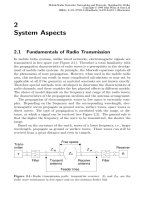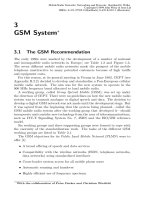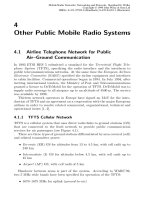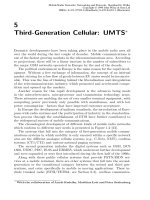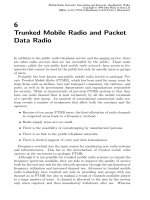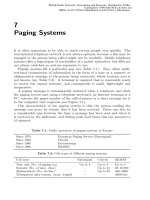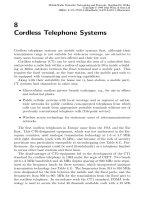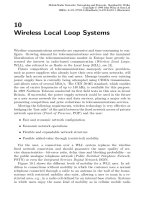Tài liệu Điện thoại di động mạng lưới Radio P4 pptx
Bạn đang xem bản rút gọn của tài liệu. Xem và tải ngay bản đầy đủ của tài liệu tại đây (457.71 KB, 19 trang )
4
Other Public Mobile Radio Systems
4.1 Airline Telephone Network for Public
Air–Ground Communication
In 1993 ETSI RES 5 submitted a standard for the Terrestrial Flight Tele-
phone System (TFTS), specifying the radio interface and the interfaces to
public telecommunications networks. At the same time the European Airlines
Electronic Committee (EAEC) specified the airline equipment and interfaces
to cabin facilities. Commercial operations began in 1994. In July 1994, after
inviting international tenders, the Ministry of Post and Telecommunications
granted a licence to DeTeMobil for the operation of TFTS. DeTeMobil was to
supply radio coverage to all airspace up to an altitude of 4500 m. The service
was available by 1996.
Thirteen network operators in Europe have signed an MoU for the intro-
duction of TFTS and an agreement on a cooperation with the major European
airlines in order to resolve related commercial, organizational, technical and
operational issues [1, 2].
4.1.1 TFTS Cellular Network
TFTS is a cellular system that uses direct radio links to ground stations (GS)
that are connected to the fixed network to provide public communication
services for air passengers (see Figure 4.1).
There are three types of ground stations differentiated by area covered (cell)
and related transmitter power:
• En-route (ER) GS for altitudes from 13 to 4.5 km, with cell radii up to
240 km
• Intermediate (I) GS for altitudes below 4.5 km, with cell radii up to
45 km
• Airport (AP) GS, with cell radii of 5 km
Handover between areas is part of the system. According to WARC’92,
two 5 MHz wide bands have been specified for operation of the TFTS:
• 1670–1675 MHz for uplink (ground-to-air)
Mobile Radio Networks: Networking and Protocols. Bernhard H. Walke
Copyright © 1999 John Wiley & Sons Ltd
ISBNs: 0-471-97595-8 (Hardback); 0-470-84193-1 (Electronic)
302 4 Other Public Mobile Radio Systems
h
h
ER, MAX
INT, MAX
43000 ft (14 km)
15000 ft (4.6 km)
EN-ROUTE GS
INTERMEDIATE GS
AIRPORT GS
Figure 4.1: Coverage areas and ground stations
1/33 MHz 1/33 MHz
Channel
Channel
#1
#1
#2
#2
#164
#164
Uplink
Downlink
1670
1675
(MHz)
1800
1805
(MHz)
Figure 4.2: TFTS channel map
• 1800–1805 MHz for downlink
The system offers automatic dialled connections to PSTN/ISDN without
any limitation on target subscribers, with the same quality of service as cus-
tomary in PLMNs.
In addition to speech, data services such as facsimile, data transfer at
4.8 kbit/s and DTMF signalling are supported. Calls from the ground to an
aircraft are only allowed to be made for operational purposes or for paging.
The user is billed directly by (credit) card for services used.
4.1.2 Frequency and Time-Multiplexing Channels
Each 5 MHz band is divided into 164 FDM channels (each 30.45 kHz wide);
see Figure 4.2.
Each FDM channel transmits at 44.2 kbit/s gross. On the uplink this
capacity is divided into 17 time channels based on the TDM method, and on
4.1 Airline Telephone Network for Public Air–Ground Communication 303
Traffic
Channel
#1
#2
#3
#4
TDMA
Frame
(80 ms)
4.706 ms
Traffic/Control/
Specific Data
Sync
Data
Guard
Guard
2.5 11 192
2.5
(bit)
208 bit (4.706 ms)
Figure 4.3: Frames and time slots
the downlink into 17 time channels based on the TDMA method. Each FDM
channel carries four voice channels.
According to Figure 4.3, 17 time slots are combined into a frame of 80 ms
duration, and 20 frames form a superframe of the duration of 1.6 s. Each time
slot contains 208 bits and has a duration of 4.706 ms.
4.1.3 Voice and Data Transmission
Voice signals are digitally coded into blocks of 192 bits and transmitted at
9.6 kbit/s in time slots. A 9.6 kbit/s voice channel occupies 4 of the 17 time
slots of an FDM channel; the 17th slot is used for network control.
As soon as voice codecs are available for a 4.8 kbit/s transmission rate, the
number of voice channels will be doubled. Data services at 4.8 kbit/s require
2 time slots per frame, therefore each FDM channel carries 8 data channels.
4.1.4 Functional Characteristics
Each aircraft has transmitting and receiving facilities (transceiver), which can
be tuned selectively to one of the different FDM channels. Four communica-
tions can be carried out on the same FDM channel at the same time. Ground
stations can transmit to different aircrafts simultaneously (on different time
channels) on each one of their FDM channels.
Signals are transmitted digitally with linear π/4-DQPSK (Differential
Quadrature Phase Shift Keying) modulation, and require a simple non-
coherent receiver.
304 4 Other Public Mobile Radio Systems
GS GS
GS
GS
GSC
GSC
PSTN/ISDN/PSPDN
OMC
NMC
AC
Figure 4.4: Architecture of a complete TFTS network
Handover can be initiated by the mobile or the ground station, and is
controlled by signal quality, distance and flight state. The particular ground
station selected as a target is the one towards which the mobile station is
moving.
The distance between mobile and ground stations is estimated on the basis
of signal propagation delay time. This information also determines the net-
work synchronization for the ground stations capable of receiving. Ground
stations are linked to the fixed network through ground switching centres
(GSC) (see Figure 4.4).
The GSC has responsibility for all the ground stations linked to it, and its
tasks include mobility management, connection establishment to mobile sub-
scribers, handover control and dynamic frequency management. The TFTS
fixed network additionally contains three management components, namely:
• Operations and maintenance centre (OMC)
• Network management centre (NMC)
• Administration centre for billing (AC)
The MoU group produced a coordinated introduction plan for the TFTS
ground network to enable the system to be introduced throughout Europe.
This effort required a cooperation between telecommunications network oper-
ators and airlines.
4.2 The US Digital Cellular System (USDC) 305
1
7
10
11
2
3
4
5
8
9
12
13
14
15
16
19
20
21
22
17
18
24
25
26
27
28
29
30
31
32
33
34
35
36
42
40
6
Figure 4.5: Cellular coverage through en-route ground stations in Europe
4.1.5 Ground Stations and Frequency Plan
En-route ground stations are spaced approximately 380 km apart according
to a hexagonal grid, with a nominal range of approximately 240 km, which
cannot be exceeded for signal propagation reasons (see Figure 4.5).
Cochannel ground stations are planned at a distance of 760 km, and neigh-
bouring channel cells at a distance of at least 600 km. Cell planning is more
difficult compared with terrestrial cellular networks because of the need to
incorporate flying altitudes.
4.2 The US Digital Cellular System (USDC)
During the 1980s there was an impressive increase in the number of subscribers
to the public cellular mobile radio network in the USA. Because approval for
the installation of new base stations and antennas is expensive and difficult to
obtain in larger cities, only a portion of this increased need for capacity could
be accommodated through a reduction in cell sizes. A permanent solution
turned out to be the development of a digital system capable of coping with
increased capacity without the need for new base stations.
In March 1988 the Telecommunication Industries Association (TIA) set
up the TR-45.3 subcommittee to develop the standard for a cellular digital
system. This digital system, the American Digital Cellular System (ADC),
306 4 Other Public Mobile Radio Systems
Mobile Station
MS
Base Station
BS
E
A
Um
Sm
B
D
G
Visitor Location
AC
PSTN
ISDN
H
F
Ai
Di
C
Centre
Authentication
Public Switched
Register
VLR
Visitor Location
Register
VLR
Home Location
HLR
Register
Equipment Identity
Register
EIR
MSC
Mobile Switching
Centre
Mobile Switching
MSC
Centre
Telephone Network
Figure 4.6: Functional architecture of the USDC system
was to support and be compatible with the existing analogue mobile radio
network, the American Mobile Phone System (AMPS); see [3]. The digital
system operates in the frequency range of the analogue AMPS system at
the same time, which allows individual channels to change over gradually to
digital technology. A characteristic of this system is that terminal equipment
can be used for analogue as well as for digital operation (dual-mode). In
addition to increased capacity, the ADC standard enables the introduction
of new services, such as authentication, a data service and a short-message
service, which were not supported by AMPS.
In 1990 the digital standard was accepted by industry as Interim Stan-
dard 54 (IS-54). The North American digital system with the architecture
illustrated in Figure 4.6 is now called US Digital Cellular (USDC). In ad-
dition, a number of standards have been accepted by FCC for the Personal
Communication System PCS 1900 market, e.g., IS-134.
4.2.1 Technical Data on the USDC System
The USDC system uses the 824–849 MHz frequency band for transmission
between mobile station and base station (uplink), and in the reverse direc-
tion (downlink) the 869–894 MHz band. The duplex separation between the
transmit and receive frequency is therefore 45 MHz. The frequency bands
are divided into FDM channels with a 30 kHz bandwidth, thereby providing
832 frequency carriers.
4.3 CDMA Cellular Radio According to US-TIA/IS-95 307
Slot 1 Slot 2 Slot 3 Slot 4 Slot 5 Slot 6
20 ms
6.7 ms
Figure 4.7: Structure of a TDMA frame in the USDC system with half-rate chan-
nels
The modulation technique used is π/4-DQPSK (Differential Quadrature
Phase Shift Keying), a four-level scheme that, although it produces higher
spectral efficiency than GMSK, places a heavy demand on the linearity of
the output amplifier. In addition, for optimal detection at the receiver in-
put, filters with a transmission function capable of describing the root of the
Nyquist transmission function are required, and this is something that in-
expensive filters can only approximate. In contrast to GMSK, π/4-DQPSK
contains different amplitude components. The eight different phase states in
π/4-DQPSK modulation are all in one circle, but the four allowed phase tran-
sitions from one phase to another do not run in the circle. This means that
not only the phase but also the amplitude is covered in the specifications for
modulation.
Like the GSM system, the USDC system operates in time-division multi-
plexing (TDM) and multiple access (TDMA) mode, albeit with three voice
channels being transmitted over one carrier. The length of the TDMA frame
is 20 ms and is divided into three time slots each of 6.7 ms duration. The
modulation data rate per FDM channel (3 time slots, 30 kHz) is 48.6 kbit/s.
After the development and introduction of a half-rate codec, a TDMA frame
will contain six time slots (see Figure 4.7) [5].
The USDC system uses a VSELP speech codec (Vector Sum Excited Linear
Prediction) which, compared with GSM, results in lower source rates. With
a full-rate codec, voice coding together with error-protection coding produces
an overall transmission rate of 13 kbit/s, whereas the total rate on the SACCH
is 0.6 kbit/s.
4.3 CDMA Cellular Radio According to
US-TIA/IS-95
TIA Interim Standard 95 was developed by QUALCOMM. Unlike IS-54,
which guarantees compatibility of a digital system with analogue, the IS-95
standard defines a CDMA transmission system. It includes the lowest three
levels of the OSI reference model. The transmission system of the LEO sys-
tem Globalstar will be based on the IS-95 standard with modifications (see
Section 14.3.3). The physical layer is described below. However, only the
